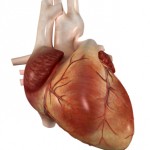Clozapine-Induced Myocarditis More Common Than Thought
 New research indicates that myocarditis, inflammation of the middle layer of the heart wall, occurs in about 3% of patients who begin taking clozapine (Clozaril). Researcher Kathlyn J. Ronaldson and colleagues recently published research to this effect in the journal Acta Psychiatrica Scandinavica. Many cases of myocarditis, which can be fatal, begin with fever. Other symptoms include rapid or abnormal heart rhythms, shortness of breath, fluid retention, and fatigue. Because the illness resembles a viral infection, it may be misdiagnosed.
New research indicates that myocarditis, inflammation of the middle layer of the heart wall, occurs in about 3% of patients who begin taking clozapine (Clozaril). Researcher Kathlyn J. Ronaldson and colleagues recently published research to this effect in the journal Acta Psychiatrica Scandinavica. Many cases of myocarditis, which can be fatal, begin with fever. Other symptoms include rapid or abnormal heart rhythms, shortness of breath, fluid retention, and fatigue. Because the illness resembles a viral infection, it may be misdiagnosed.
In 2010 Ronaldson and colleagues reported in the Journal of Clinical Psychiatry that tachycardia (rapid resting heart rate) and elevated levels of a group of proteins knows as troponin in the blood are almost always present during the first 45 days of treatment in patients who develop myocarditis. The researchers found that the time to onset of myocarditis was 14 to 22 days in almost all cases. Eosinophilia (high levels of a certain type of white blood cell) may occur in the week after peak troponin levels, and high levels of the inflammatory protein CRP (above 100mg/L) occurred in 79% of cases.
Ronaldson and colleagues suggest that patients who are prescribed clozapine be monitored for myocarditis during the first four weeks of treatment, particularly during the third week.
Lifetime Heart Disease Risk Increases Dramatically When One or More Risk Factors Are Present in Middle Age
A meta-analysis of 18 studies that was published by Donald Lloyd-Jones in the New England Journal of Medicine in 2012 shows that increasing cardiovascular risk factors during middle age can dramatically increase a person’s risk of experiencing fatal cardiovascular disease, fatal coronary heart disease, nonfatal heart attack, or stroke later in life.
Data were analyzed from 257,384 patients, who included black and white men and women spanning a 50-year range of birth cohorts. The studies examined cardiovascular risk factors such as smoking, cholesterol levels, diabetes, and blood pressure at ages 45, 55, 65, and 75.
Having even one risk factor at age 55 dramatically increased the lifetime risk of cardiovascular disease compared to having no risk factors, and having more risk factors during middle age increased risk even further. Among people with no risk factors at age 55 (meaning cholesterol under 180mg/dL, blood pressure under 120 mm Hg systolic and 80 mm HG diastolic, nonsmoking and nondiabetic), men had 4.7% risk of death from cardiovascular disease by age 80 (compared to 29.6% for those with 2 or more risk factors). Women had a 6.4% risk of death from cardiovascular disease by age 80 (compared to 20.5% among those with 2 or more risk factors).
Lifetime risk of death from cardiovascular disease and coronary heart disease and risk of nonfatal heart attack were about twice as high in men, while risk of stroke was similar for men and women.
Across race, trends were similar, but this finding can be misleading. While African-Americans have more cardiovascular risk factors than whites, they are also more likely to die at younger ages from other causes before developing serious cardiovascular illnesses. Large studies with Latino and Asian American participants were begun too recently to provide robust data about long-term risk, but this research is expected to become available soon.
Editor’s Note: Watch your risk factors for heart disease, including high blood pressure, cholesterol, weight, and blood sugar. The more risk factors one has, the greater the increased risk of fatal cardiovascular illness.
Depression is also a risk factor for coronary artery disease, and should be treated just as aggressively and persistently as the other risk factors. Exercise is one element of a healthy lifestyle that can positively affect all of these risk factors. Implementing a healthy diet and exercise regimen by middle age will have long-term positive effects in reducing risks in older ages.
Depressive Symptoms Negate Effects of Heart-Healthy Behaviors
Physical activity and light to moderate drinking (as is often associated with the Mediterranean diet) are recommended as ways to reduce risk for heart disease and type 2 diabetes. New research shows that among healthy people, symptoms of depression can counteract the anti-inflammatory benefits of both exercise and light to moderate alcohol consumption.
C-reactive protein (CRP) is a cardiometabolic risk marker. High measures of CRP are a sign of inflammation. Leisure-time physical activity and light to moderate alcohol intake (defined as about half a drink per day for women and one drink per day for men) are associated with lower levels of CRP. Depression is associated with higher levels.
A study by Edward C. Suarez et al. published recently in the journal Brain, Behavior, and Immunity examined 222 nonsmoking men and women aged 18-65 years. These participants were physically healthy and had no history or diagnosis of psychiatric conditions. Participants recorded the amount of alcohol they consumed and the amount of physical activity in which they participated. CRP levels in their fasting blood samples were measured, and they also completed an inventory of depressive symptoms.
Those people who were physically active had lower levels of CRP, but the 4.5% of participants with depressive symptoms did not see any anti-inflammatory benefits from physical activity. Similarly, light to moderate drinking was associated with lower levels of CRP only in men who were not depressed.
Depression did not seem to affect other markers of physical health in this study, such as levels of triglycerides or cholesterol.
Editor’s Note: This study suggests that treating depressive symptoms should be a part of any plan to reduce cardiovascular risk. It seems that depression has effects that go beyond psychological distress and may prevent patients from reaping the benefits of their healthy behaviors. The effect of depression in preventing heart healthy changes in CRP could be one of many factors mediating the high levels of cardiovascular risk in depression. People with depression are twice as likely to have a heart attack than those without depression.
Synthetic Marijuana Comes with Serious Risks, Including Risks to Fetus
Synthetic marijuana, otherwise known as spice, skank, or K2, is not only vastly more potent than the tetrahydrocannabinol (THC) in marijuana plants, but it also lacks cannabidiol (CBD), the calming, antipsychotic substance also present in the plants. This makes spice much more likely to induce major psychiatric effects.
New evidence links use of spice during pregnancy to a tragic birth defect, anencephaly, or absence of the cerebral cortex. It can also lead to the later development of attention-deficit hyperactivity disorder, learning disabilities, memory impairment, depression, and aggression.
of spice during pregnancy to a tragic birth defect, anencephaly, or absence of the cerebral cortex. It can also lead to the later development of attention-deficit hyperactivity disorder, learning disabilities, memory impairment, depression, and aggression.
Effects of THC on gestation may occur as early as two weeks after conception, meaning by the time a woman realizes she is pregnant, the fetus may have been harmed by exposure to the drug.
Other new finding associate use of spice with acute coronary syndrome and the kind of acute kidney injury that can lead to the organ shutting down.
Editor’s Note: It has now been found that synthetic marijuana, or spice, can lead to psychosis, delirium, acute coronary syndrome (heart attack) in young people, and now kidney dysfunction, in addition to causing birth defects if used by pregnant women. Not only is spice made up of more potent THC without the calming effects of CBD, but it is often laced with unknown contaminants, which are likely the cause of the heart and kidney damage.
Smoking regular marijuana is bad enough—it doubles the risk of psychosis and may precipitate the onset of schizophrenia. It may also cause long-lasting effects on cognitive function. Since many states are legalizing marijuana, it is important to know the risks. In any case the risks are much more serious with the synthetic product, and synthetic marijuana should be avoided at all costs.
Keep Your Heart and Cardiovascular System Healthy
 Middle aged folks, watch your risk factors for cardiovascular disease. These include: high blood pressure, cholesterol, weight, and blood sugar (diabetes).
Middle aged folks, watch your risk factors for cardiovascular disease. These include: high blood pressure, cholesterol, weight, and blood sugar (diabetes).
According to Heartwire, an article in the New England Journal of Medicine indicates that having any of these risk factors increases the likelihood of cardiovascular disease later in life. The more risk factors one has, the greater the increase in risk.
Across the whole meta-analysis, participants with no risk factors at age 55 (total cholesterol level: <180 mg/dL;
blood pressure: <120 mm Hg systolic and 80 mm Hg diastolic; nonsmoking; nondiabetic) had drastically better odds
of avoiding death from cardiovascular disease through the age of 80 than participants with two or more major risk
factors (4.7% vs 29.6% among men and 6.4% vs 20.5% among women).People with an optimal risk-factor profile also had lower lifetime risks of fatal coronary heart disease or nonfatal MI (Editor’s Note: myocardial infarction, or heart attack) (3.6% vs 37.5% among men, <1% vs 18.3% among women) and fatal or nonfatal stroke (2.3% vs 8.3% among men,
5.3% vs 10.7% among women), compared with those with two or more risk factors.
What this article does not mention is that depression is a risk factor for coronary artery disease, and should be treated just as aggressively and persistently as the other cardiovascular risk factors.
Also as we’ve written before in the BNN, exercise is one element of a healthy life style that can positively affect all of these risk factors. Starting a healthy diet and exercise regimen in middle age will have long-term positive effects and reduce risks later in life.



